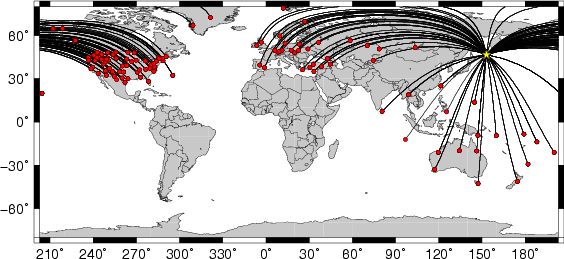
Location of the earthquake (yellow star) and great circle path from the epicenter to each station (red) [created using GMT (Wessel, P., and W. H. F. Smith, New version of Generic Mapping Tools released, EOS Trans. AGU, 76 329, 1995.)]
2006/11/15 11:14:16 46.61 153.23 30
The following compares this source inversion to the USGS Rapid Moment Tensor Solution and to the Harvard CMT solutions, if they are available.
SLU Moment Tensor Solution
2006/11/15 11:14:16
Best Fitting Double Couple
Mo = 7.76e+27 dyne-cm
Mw = 7.86
Z = 110 km
Plane Strike Dip Rake
NP1 30 70 80
NP2 237 22 116
Principal Axes:
Axis Value Plunge Azimuth
T 7.76e+27 64 284
N 0.00e+00 9 33
P -7.76e+27 24 128
Moment Tensor: (dyne-cm)
Component Value
Mxx -2.33e+27
Mxy 2.76e+27
Mxz 2.53e+27
Myy -2.59e+27
Myz -5.30e+27
Mzz 4.91e+27
--------------
---------------------#
---------###############-###
------###################----#
------#####################-------
-----#######################--------
----########################----------
----#########################-----------
---#########################------------
---########## ############--------------
---########## T ###########---------------
--########### ##########----------------
--#######################-----------------
-######################-----------------
-#####################------------------
-###################---------- -----
#################------------ P ----
##############-------------- ---
###########-------------------
#######---------------------
#---------------------
--------------
Harvard Convention
Moment Tensor:
R T F
4.91e+27 2.53e+27 5.30e+27
2.53e+27 -2.33e+27 -2.76e+27
5.30e+27 -2.76e+27 -2.59e+27
|
6/11/15 11:14:16.76
KURIL ISLANDS
Epicenter: 46.683 153.224
MW 7.9
USGS MOMENT TENSOR SOLUTION
Depth 7 No. of sta: 92
Moment Tensor; Scale 10**20 Nm
Mrr= 3.58 Mtt=-4.14
Mpp= 0.56 Mrt= 6.36
Mrp= 4.16 Mtp=-1.87
Principal axes:
T Val= 8.23 Plg=58 Azm=316
N 0.94 8 60
P -9.17 31 155
Best Double Couple:Mo=8.7*10**20
NP1:Strike=270 Dip=16 Slip= 121
NP2: 58 76 81
-------
-----------------
-----###########-----
---###################---
---#######################---
--##########################-##
-######### ##############---#
-########## T ############------#
########### ##########---------
#####################------------
##################---------------
###############------------------
###########--------------------
#######------------ ---------
------------------ P --------
---------------- ------
---------------------
-----------------
-------
|
November 15, 2006, KURIL ISLANDS, MW=8.3
Meredith Nettles
Goran Ekstrom
CENTROID, MOMENT TENSOR SOLUTION
HARVARD EVENT-FILE NAME C111506A
DATA USED: GSN
L.P. BODY WAVES: 33S, 53C, T= 50
MANTLE WAVES: 79S,210C, T=200
CENTROID LOCATION:
ORIGIN TIME 11:15: 9.0 0.1
LAT 46.75N 0.01;LON 154.32E 0.01
DEP 13.4 0.6;HALF-DURATION 34.3
MOMENT TENSOR; SCALE 10**28 D-CM
MRR= 1.67 0.01; MTT=-0.51 0.01
MPP=-1.17 0.01; MRT= 1.57 0.11
MRP= 2.47 0.15; MTP=-0.77 0.00
PRINCIPAL AXES:
1.(T) VAL= 3.37;PLG=60;AZM=302
2.(N) 0.00; 0; 33
3.(P) -3.38; 30; 123
BEST DOUBLE COUPLE:M0=3.4*10**28
NP1:STRIKE=214;DIP=15;SLIP= 92
NP2:STRIKE= 33;DIP=75;SLIP= 90
-----------
----##############-
---#################---
---###################-----
---###################-------
---###################---------
--####### ##########---------
--######## T #########-----------
--######## ########------------
--#################--------------
--################---------------
-###############-------- ----
--#############--------- P ----
-###########----------- ---
-########------------------
-####------------------
#------------------
-----------
|
The following broadband stations passed the QC and were used for the source inversion. AAK AAM AFI AGMN AMTX ANMO ANTO ARU BBSR BFO BINY BLA BMO BRAL BRVK BW06 CART CBKS CBN CHTO CMB CNNC COCO COLA COR CSS CTAO DAV DGMT DSB DUG DWPF ECSD EGAK EGMT ESK EYMN FUNA GNI GRFO GUMO HAWA HKT HLID HNR HRV HUMO HWUT ISP JCT JFWS KBS KEV KIEV KIV KONO KSU1 KURK KVTX KWP LAO LBNH LKWY LOHW LONY LTX MALT MBWA MCWV MNTX MOOW MORC MSO MVCO NCB NEW NWAO OBN OXF PAB PALK PFO PKME PMG POHA PSZ RAO RAR RGN RSSD SANT SAO SCIA SFJD SNOW SNZO SSPA STU SUMG SUW TATO TAU TLY TUC TZTN WLF WMOK WRAB WRAK WUAZ WVOR WVT
All observed and Greens function waveforms are corrected to instrument response to ground velocity in meters/sec for the passband of 0.004 - 5 Hz. The traces were then lowpass filtered at 0.25 Hz and interpolated to a sample rate of 1 second.
For the grid search, the observed traces and Green's functions are read in an cut using the following commands
Phase Gsac Command Comment P cut A -30 A CUTH = 95+0.3*DEPTH SH cut T1 -60 T1 CUTH = 95+0.6*DEPTH SV cut T0 -60 T0 CUTH = 95+0.6*DEPTH where the 95 is a maximum filter duration, DEPTH is in km, and the CUTH in secThe cut windows attempt to include the P, pP, sP, pS, S and sS arrivals. However, oen must be very careful about the fact that PP may be included in some distance ranges.
The waveforms are then bandpass filtered by the application of the following high- and low-pass stages (an optional microseism filter):
hp c 0.0050 2 lp c 0.0100 2 int br c 0.12 0.2 n 4 p 2The traces were next integrated to ground displacment in meters. Finally the observed data are interpolated to ahve the same sampling at the Green's functions.
The source inversion is a multipass operation since a lower frequency filter band is used for larger earthquakes and since a search is made over depth. Up to three passed of the outer loop are made, after which the moment magnitude is determined and filter settings readjusted. The inner loop over depth samples all depths from 0 to 800 km with 5 km increments in depth to 50 km, followed by 10 km depth sampling for the remaining range.
The following filter ranges are used according to the moment magnitude Mw:
FILTER_BAND FH(s) FL(s)
1 60 12 Mw < 6.4
2 100 20 6.4 < Mw <= 6.9
3 120 40 Mw > 6.9
The map displays the distribution of stations used for this source inversion.

Location of the earthquake (yellow star) and great circle path from the epicenter to each station (red) [created using GMT (Wessel, P., and W. H. F. Smith, New version of Generic Mapping Tools released, EOS Trans. AGU, 76 329, 1995.)] |
For this data set the favored solution is
WVFMTD96 200.0 30. 63. 86. 7.92 0.433 0.165E-03 0.458 0.659 0.694E-04 24.9
The following figures show the sensitivity of the goodness of fit parameter so source depth, the waveform comparison as a function of epicentral distance in degrees and the source to station azimuth
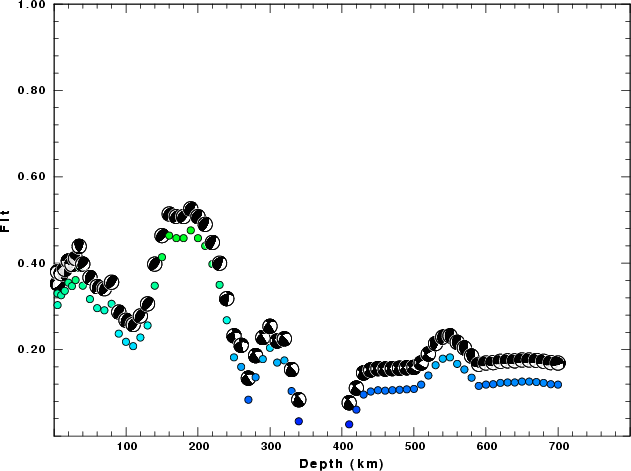
|
| Goodness of fit as a function of source depth. The measure is 1 - SUM (o -p)2 / SUM o2. A value of 1.0 is the best fit. The best double couple mechanism for the solution depth is plotted above goodness of fit value to indicate how the mefhanism may change with depth. |
| P-wave Z component |
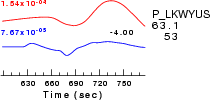
|
| Comparison of the observed traces (red) and solution predicted traces (blue) ordered in terms of increasing epicentral distance. Each pair of traces is annotated with the station name, epicentral distance in degrees, source to station azimuth in degrees. Each pair of traces is plotted with the same scale and the peak amplitudes are indicated at the lect of each trace. Finally the time shift between the P-wave first arrival picked and the the theoretical P-wave first arrival in the predicted trace is indicated, with a positive sign indicating that the predicted trace has been shifted to the right by the given number of seconds. as a function of source to station azimuth in degrees (D). The purpose of this display is to highlight the azimuthal dependence on the first motion. The traces are annotated with the station name at the top. |
| SH-wave T component |
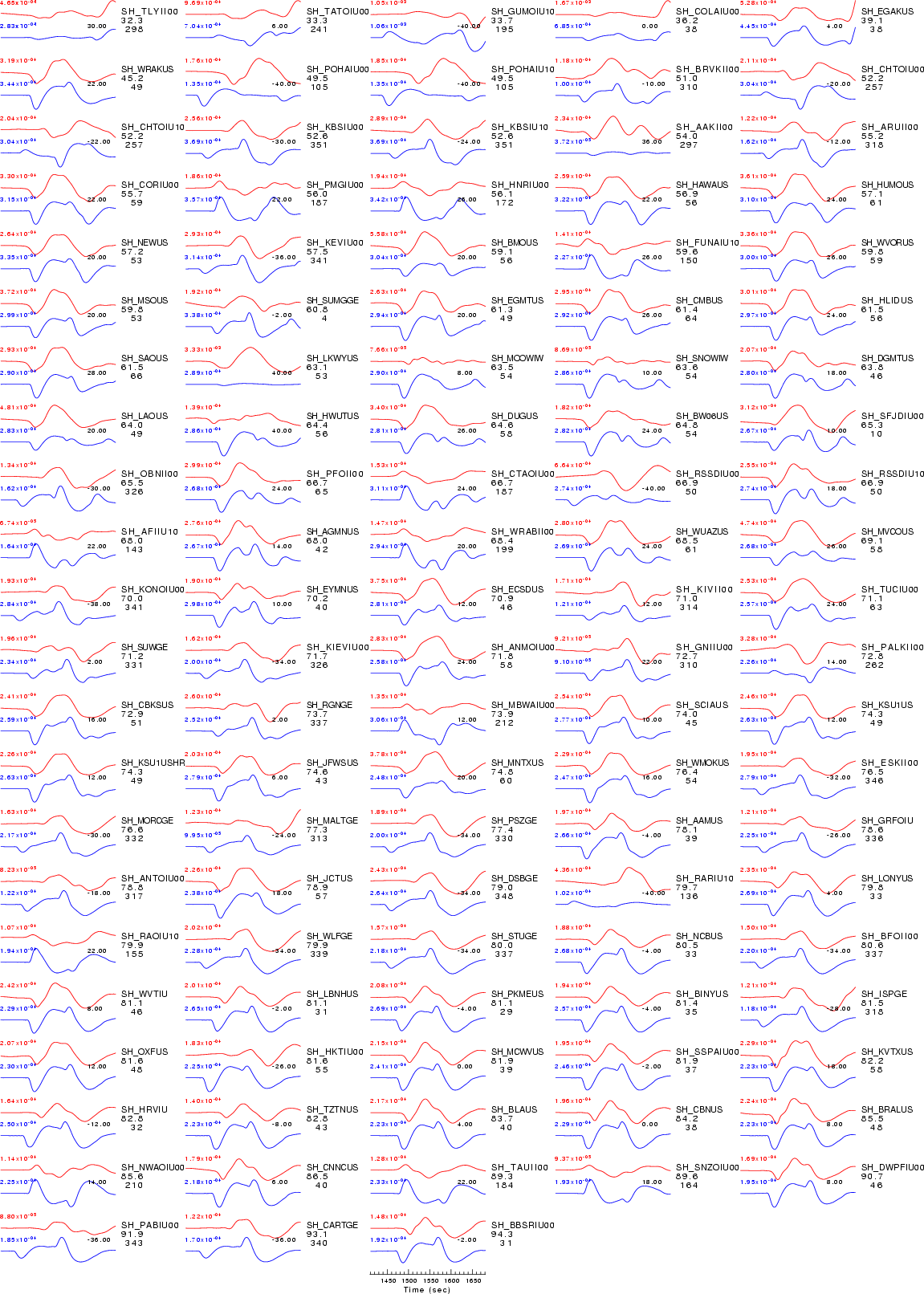
|
| Comparison of the observed traces (red) and solution predicted traces (blue) ordered in terms of increasing epicentral distance. Each pair of traces is annotated with the station name, epicentral distance in degrees, source to station azimuth in degrees. Each pair of traces is plotted with the same scale and the peak amplitudes are indicated at the lect of each trace. Finally the time shift between the P-wave first arrival picked and the the theoretical P-wave first arrival in the predicted trace is indicated, with a positive sign indicating that the predicted trace has been shifted to the right by the given number of seconds. as a function of source to station azimuth in degrees (D). The purpose of this display is to highlight the azimuthal dependence on the first motion. The traces are annotated with the station name at the top. |
| SV-wave R component |
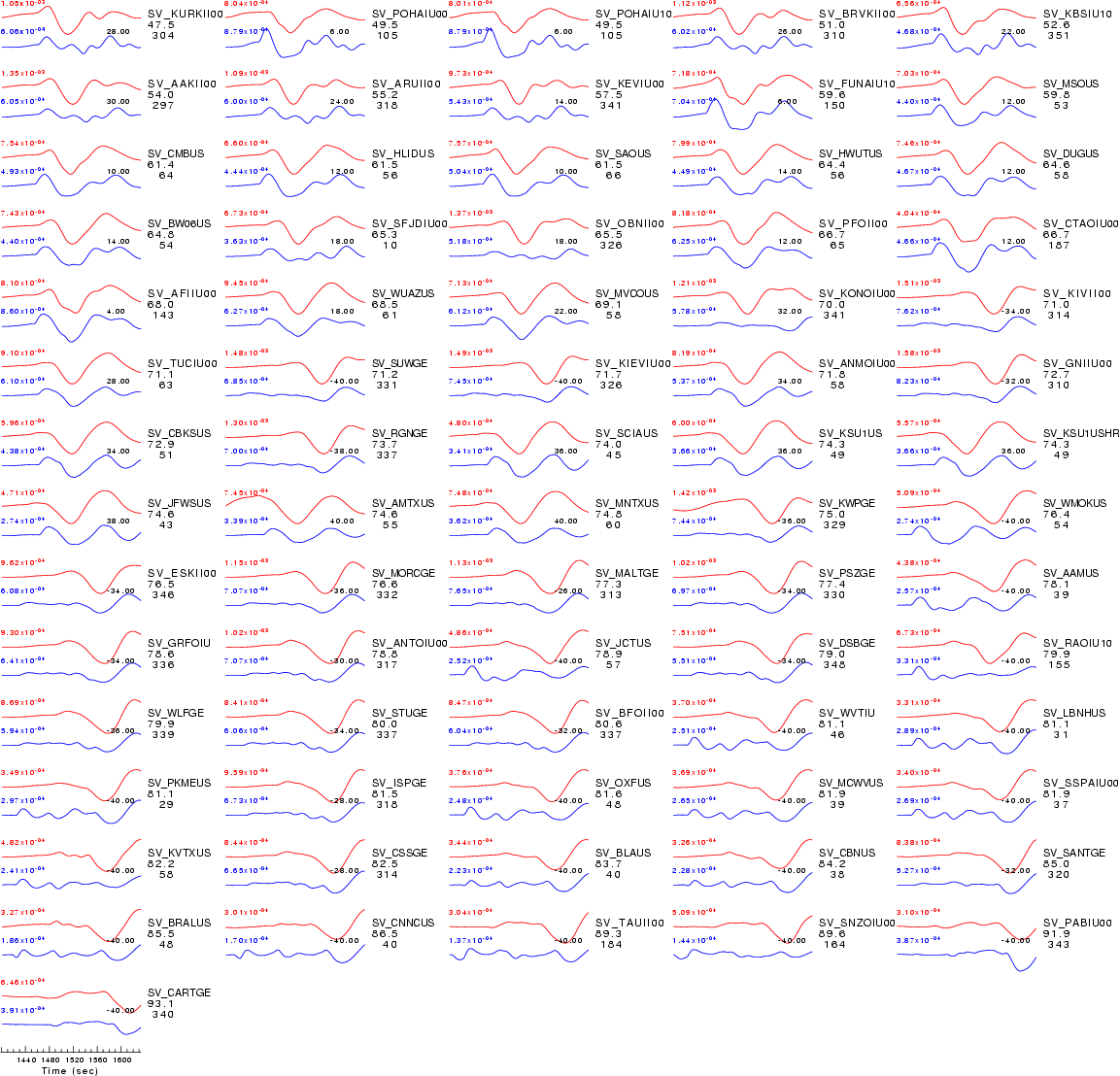
|
| Comparison of the observed traces (red) and solution predicted traces (blue) ordered in terms of increasing epicentral distance. Each pair of traces is annotated with the station name, epicentral distance in degrees, source to station azimuth in degrees. Each pair of traces is plotted with the same scale and the peak amplitudes are indicated at the lect of each trace. Finally the time shift between the P-wave first arrival picked and the the theoretical P-wave first arrival in the predicted trace is indicated, with a positive sign indicating that the predicted trace has been shifted to the right by the given number of seconds. as a function of source to station azimuth in degrees (D). The purpose of this display is to highlight the azimuthal dependence on the first motion. The traces are annotated with the station name at the top. |
All observed and Greens function waveforms are corrected to instrument response to ground velocity in meters/sec for the passband of 0.004 - 5 Hz. The traces were then lowpass filtered at 0.25 Hz and interpolated to a sample rate of 1 second.
For the grid search, the observed traces and Green's functions are read in an cut using the following commands
Phase Gsac Command Comment P cut A -30 A CUTH = 95+0.3*DEPTH SH cut T1 -60 T1 CUTH = 95+0.6*DEPTH SV cut T0 -60 T0 CUTH = 95+0.6*DEPTH where the 95 is a maximum filter duration, DEPTH is in km, and the CUTH in secThe cut windows attempt to include the P, pP, sP, pS, S and sS arrivals. However, oen must be very careful about the fact that PP may be included in some distance ranges.
The waveforms are then bandpass filtered by the application of the following high- and low-pass stages (an optional microseism filter):
hp c 0.0050 2 lp c 0.0100 2 int br c 0.12 0.2 n 4 p 2The traces were next integrated to ground displacment in meters. Finally the observed data are interpolated to ahve the same sampling at the Green's functions.
The source inversion is a multipass operation since a lower frequency filter band is used for larger earthquakes and since a search is made over depth. Up to three passed of the outer loop are made, after which the moment magnitude is determined and filter settings readjusted. The inner loop over depth samples all depths from 0 to 800 km with 5 km increments in depth to 50 km, followed by 10 km depth sampling for the remaining range.
The following filter ranges are used according to the moment magnitude Mw:
FILTER_BAND FH(s) FL(s)
1 60 12 Mw < 6.4
2 100 20 6.4 < Mw <= 6.9
3 120 40 Mw > 6.9
The map displays the distribution of stations used for this source inversion.
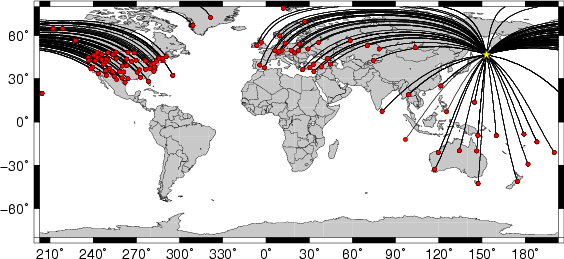
Location of the earthquake (yellow star) and great circle path from the epicenter to each station (red) [created using GMT (Wessel, P., and W. H. F. Smith, New version of Generic Mapping Tools released, EOS Trans. AGU, 76 329, 1995.)] |
For this data set the favored solution is
WVFGRD96 110.0 30 70 80 7.86 0.5539
The following figures show the sensitivity of the goodness of fit parameter so source depth, the waveform comparison as a function of epicentral distance in degrees and the source to station azimuth
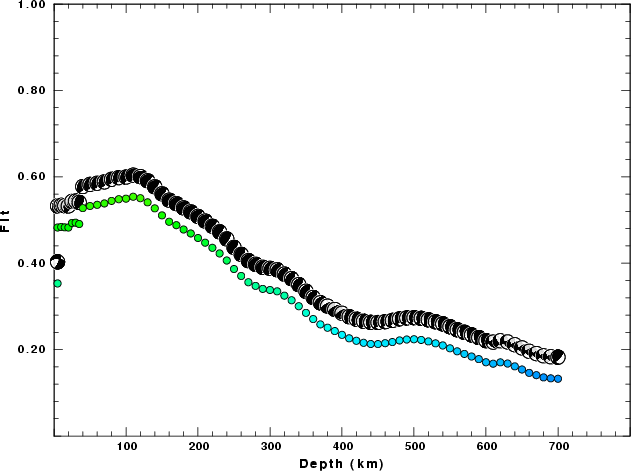
|
| Goodness of fit as a function of source depth. The measure is 1 - SUM (o -p)2 / SUM o2. A value of 1.0 is the best fit. The best double couple mechanism for the solution depth is plotted above goodness of fit value to indicate how the mefhanism may change with depth. |
| P-wave Z component |
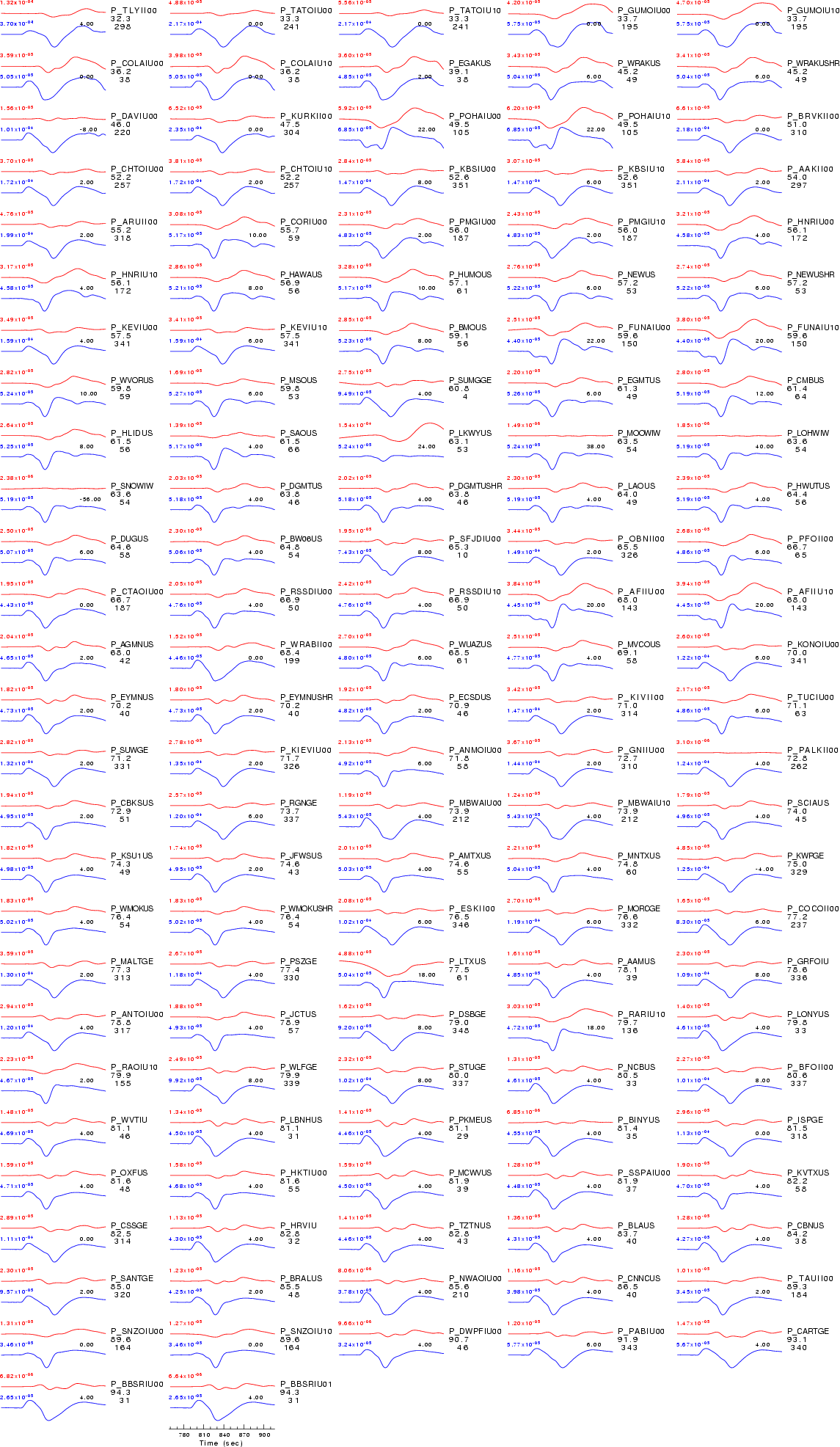
|
| Comparison of the observed traces (red) and solution predicted traces (blue) ordered in terms of increasing epicentral distance. Each pair of traces is annotated with the station name, epicentral distance in degrees, source to station azimuth in degrees. Each pair of traces is plotted with the same scale and the peak amplitudes are indicated at the lect of each trace. Finally the time shift between the P-wave first arrival picked and the the theoretical P-wave first arrival in the predicted trace is indicated, with a positive sign indicating that the predicted trace has been shifted to the right by the given number of seconds. as a function of source to station azimuth in degrees (D). The purpose of this display is to highlight the azimuthal dependence on the first motion. The traces are annotated with the station name at the top. |
| SH-wave T component |
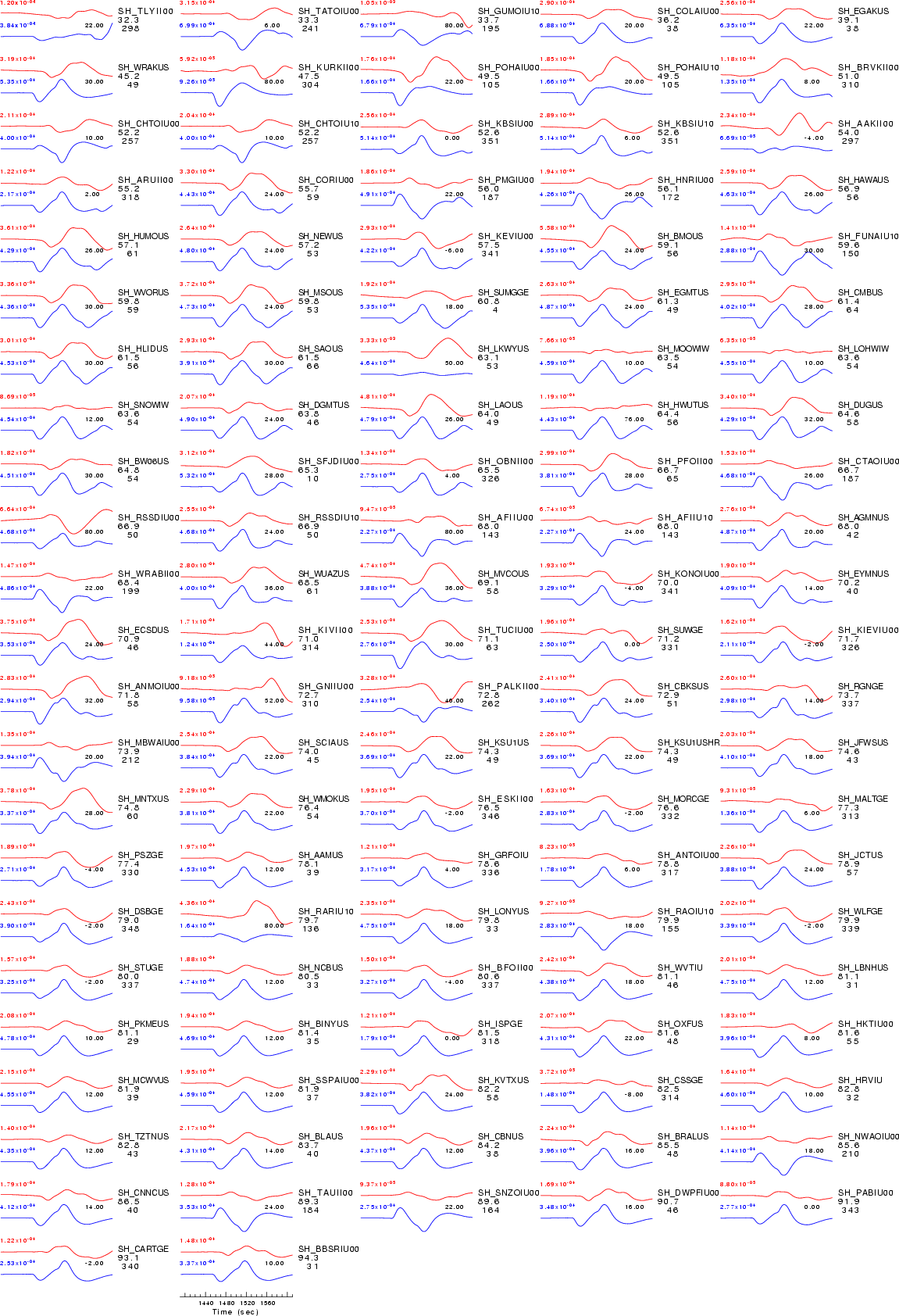
|
| Comparison of the observed traces (red) and solution predicted traces (blue) ordered in terms of increasing epicentral distance. Each pair of traces is annotated with the station name, epicentral distance in degrees, source to station azimuth in degrees. Each pair of traces is plotted with the same scale and the peak amplitudes are indicated at the lect of each trace. Finally the time shift between the P-wave first arrival picked and the the theoretical P-wave first arrival in the predicted trace is indicated, with a positive sign indicating that the predicted trace has been shifted to the right by the given number of seconds. as a function of source to station azimuth in degrees (D). The purpose of this display is to highlight the azimuthal dependence on the first motion. The traces are annotated with the station name at the top. |
| SV-wave R component |
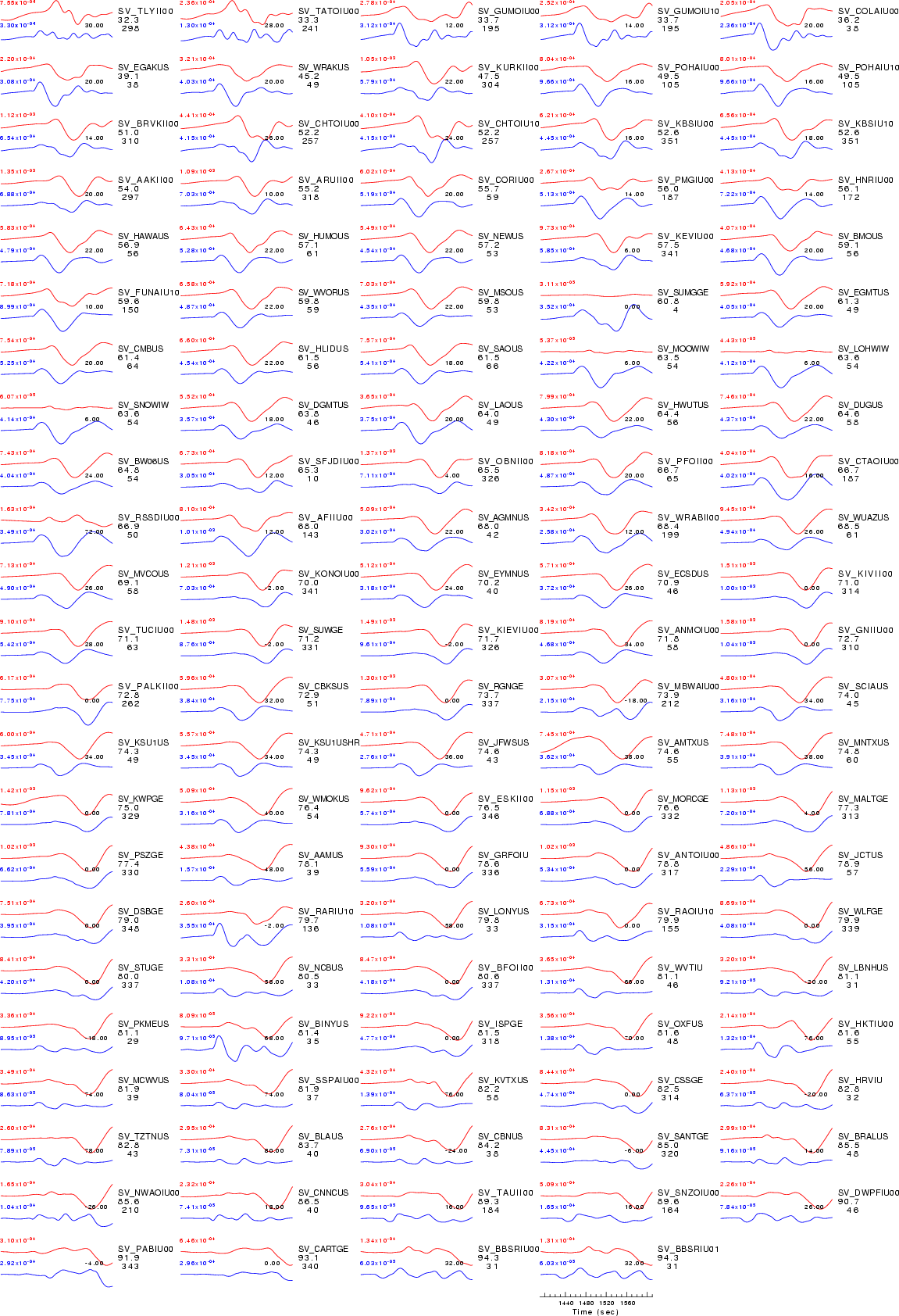
|
| Comparison of the observed traces (red) and solution predicted traces (blue) ordered in terms of increasing epicentral distance. Each pair of traces is annotated with the station name, epicentral distance in degrees, source to station azimuth in degrees. Each pair of traces is plotted with the same scale and the peak amplitudes are indicated at the lect of each trace. Finally the time shift between the P-wave first arrival picked and the the theoretical P-wave first arrival in the predicted trace is indicated, with a positive sign indicating that the predicted trace has been shifted to the right by the given number of seconds. as a function of source to station azimuth in degrees (D). The purpose of this display is to highlight the azimuthal dependence on the first motion. The traces are annotated with the station name at the top. |